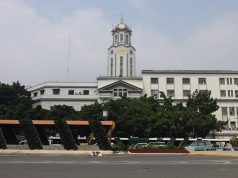
The vandalism incident in Lagusnilad underpass in the city of Manila fostered online conversations on whether the act was an art protest or plain vandalism.
Protest slogans saying “Presyo, Ibaba! Sahod, Itaas!” and “US-China Layas!” were found on the wall along the stairs of the underpass on November 12.
Since the works violate an anti-vandalism ordinance, the Department of Engineering and Public Works had already repainted over them.
A group called Panday Singing, the cultural arm of Anakbayan, eventually owned up for what they did and explained their motive for it.
“To the public: sorry for the inconvenience, but the matter and issues at hand are urgent. Left and right, ordinary people are being killed or jailed for criticizing this corrupt and fascist government,” the group said on a lengthy Facebook post.
“The space for peaceful and democratic speech is already being compromised by the regime as it pushes to criminalize dissent with its de facto Martial law nationwide in the name of Executive Order No. 70,” it added.
While art has been used as a form of protest in many movements around the world, the red letters expressing protest against China and the high cost of goods appeared to be a defacement of the newly painted wall.

Others pointed out that there are better ways to create art and campaign for a cause.

It’s the message the local government sought to erase, those who supported the activists said, and there are worse social problems that required addressing than vandalism.
“Sa gobyernong walang ibang alam kung hindi magmalinis sa mga kasalanan nito, “malinis” na mga pader at kalsada na ang pamantayan ng ‘kaunlaran.’ Pero kaunlaran para kanino? Ano ang kalinisan na tinatakpan at tinatapalan lang ang kabulukan ng lipunan?” Twitter user @pmjamilla said.
Sa araw-araw na pamamasada sa Maynila, marami kang makikitang bandalismo sa mga pader; kadalasan walang katuturan, minsan masahol—pero 'pag panawagan, tinatapalan agad o kaya kinukunan ng retrato at kinukundena.
Hindi galit ang gobyerno sa bandalismo: galit ito sa sinasabi nito. https://t.co/LZdQPnjvQk
— Philip Jamilla (@pmjamilla) November 12, 2019
The vandalized wall earlier earned the ire of Manila Mayor Isko Moreno and the Manila Tourism and Cultural Affairs Bureau.
The Lagusnilad was among the places in the capital that underwent a big makeover last July.
Moreno once floated the idea of having a freedom wall or hate wall for graffiti artists.
“Freedom wall, hate wall, whatever you call it, a wall [where] they can express themselves in an artistic manner or [express their] beliefs for that matter,” he told reporters last July.
Protest art or plain vandalism
Graffiti, murals or other forms of art have been used as ways to express dissent against the society and the government in different parts of the world for years.
An article titled “The duality of graffiti: is it vandalism or art?” notes that contemporary graffiti can be defined by “its controversial issues between social, style and aesthetic forms along with vandalism aspects.”
Graffiti and street art have varying interpretations, Alain Colombini wrote, however, the artists of both are normally in conflict with the law.
“We are now witnessing a radicalization of practices both from two points of view: legality and vandalism,” Colombini wrote.
An opinion piece on New York Times explains that graffiti is a “sub-genre” of vandalism that is recognized by its message.
“Though graffiti represents a challenge to the law — and sometimes serves as social commentary about the subjectivity of laws — it can simultaneously serve a public good through its nuanced social commentary and its artistry,” author Lu Olivero said.
What the ordinance states
Any act of writing or scribbling on the walls of any property is prohibited by virtue of Ordinance No. 7971 implemented in Manila.
Section 2 stated that:
“It shall be unlawful for any person to deface or cause to be defaced, by painting, writing, scribbling, scrawling, drawing, smearing, coloring, stamping or inscribing, the walls, siding, partitions, fences, gates, doors or window panes of buildings, edifices, houses or structures, whether public or private, lamp posts, street signs, streets, sidewalks or other public property.”
So far, there’s no specific legislation in the country that penalizes vandalism.









